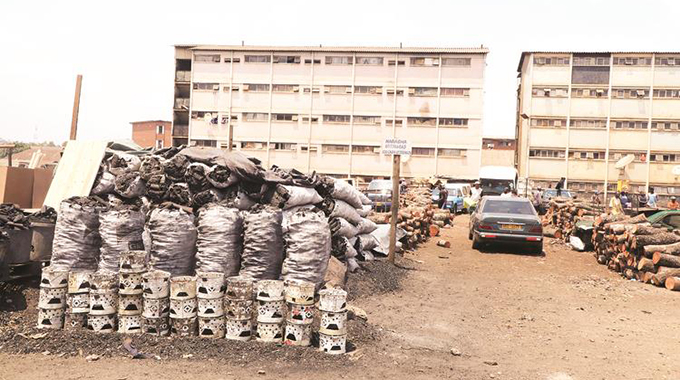Massive deforestation dents national tree planting campaign

Sifelani Tsiko Agric, Environment & Innovations Editor
It’s that time of the year when each one of us should grab a spade and sign up to the national tree planting campaign’.
People should get off their sofas and forgo their comforts to plant a tree.
Here in Zimbabwe, the first Saturday of December each year is National Tree-Planting Day.
This day was declared nearly four decades ago and has become a permanent feature of our national calendar.
Trees do not only give us an enthralling scenery in cities, farms, rural areas and in wildlife parks, but also provide significant health and well-being benefits.
They are now a vital part of our response to climate change and its damaging effect.
Planting trees here in Zimbabwe is now more pressing than at any moment in our history.
Our country needs to greatly increase its tree cover if it has any chance of meeting its commitment to cut the amount of greenhouse gas we produce each year by 2050.
At a time of global warming, we must appreciate that trees can help to suck carbon dioxide (CO2) from the atmosphere and convert it into wood in their trunks and branches.
According to the United Nations Environment Programme, 12 million hectares of trees are hacked down worldwide every year, and even here in Zimbabwe, deforestation has reached alarming proportions.
The loss of forest cover is very worrying and we need to come together as a country to arrest the rate of deforestation before it is too late.
In Zimbabwe, the major drivers of deforestation include the heavy use of charcoal as a source of energy for heating and cooking for a majority of households in both rural and urban areas.
Rising energy demands and the rolling out of power cuts lasting up to more than 10 hours daily in most parts of the country is driving up the deforestation of large tracts of forests as wood becomes the main source of heating and cooking for the majority of the poor.
Zesa, the country’s power utility, imposed the worst rolling blackouts in years, with households and industries going without electricity due to lack of foreign currency, declining water levels at Kariba Hydro Power Station and obsolete equipment at the Hwange Thermal Power Station.
Most families are increasingly relying on firewood and charcoal as prices of imported liquefied petroleum gas continue to rise.
Our landlocked country is also suffering from the effects of climate change, with land degradation, soil erosion, deforestation, recurrent droughts and flooding worsened by farming activities.
In addition to this, the illegal harvesting of timber across the country is now rampant, and it has resulted in reduced forest cover.
In most parts of the country, the destruction of forests, coupled with excessive settlement and other human activities has led to uncontrolled soil erosion, high sediment load and subsequent siltation of the country’s major dams.
It has also decreased river flows.
Timber extraction, bush fires, mining and infrastructure development have all compounded the problems.
The Forestry Commission and the Environmental Management Agency estimate that tobacco farming has been contributing about 15 percent to the loss of indigenous forests annually due to tobacco curing.
As a result, the agencies say about 330 000 hectares of trees are lost every year due to these factors.
The country has lost vast tracts of indigenous woodlands, and environmental agencies estimate that local forest cover for the country is now at 45 percent, a critical level which now requires massive tree planting programmes.
This year alone, deforestation has been massive owing to energy demands prompted by massive power cuts. If a new inventory is conducted on our tree resources, it won’t be surprising to find out that deforestation could not be gobbling more than 500 000 hectares of trees a year.
Through the National Tree Planting Day, Zimbabwe plants 15 million trees per year, but this is a far cry from the large tracts it is losing every year.
Zimbabwe aims to increase its forestry cover by 10 percent by 2030.
Without increased tree planting and an improved power supply from power stations, it is going to be difficult to arrest deforestation. We need to step up our efforts to promote forest conservation and reduce the pressure on forests as a source of wood energy. By all means possible, we must encourage the use of alternative domestic energy sources and sustainable charcoal production techniques.
As the nation gears up for the kick-off of the national tree planting exercise, everyone must join hands in this strategic campaign to increase forest cover in our country.
People must plant and commit to save thousands of trees to celebrate the national tree planting campaign.
We must encourage every Zimbabwean — young and old — to go out and plant as many trees as possible to help us reverse environmental degradation by doubling our forest cover.
Local corporates, schools, Government agencies, private and public institutions, NGOs and individuals need to ensure a sustained adoption of a tree planting and nurturing culture.
Beyond the planting stage, trees will also need to be cared for to ensure they survive.
Our rural and urban councils must revitalise their nursery tree programmes to green our cities and countryside.
With the violent storms that have hit Harare and most other parts of the country, most councils have embarked on a vicious tree-cutting exercise to minimise damage to people and property, but without any compensating strategy to re-plant trees.
Trees in Harare and most other urban areas in the country have been subject to vandalism and dumping of waste, leading to their destruction.
People have added to the woes by not supporting the survival of trees on the streets.
Planting trees is one thing and ensuring their survival quite another.
Trees have lots of benefits. They can reduce pollutants, limit the urban “heat island effect” and reduce air conditioning needs, control erosion, landslides, surface water flow and flooding.
They can also boost biodiversity, improve well-being and elevate property values.
Experts says a single tree can store up to 150kg of carbon dioxide per year, an important benefit given that urban areas produce an estimated 75 percent of the gas’ emissions globally.
From the forests, we also derive non – wood forest products such as honey, madora, wild mushrooms and variety of other products. These may be seasonal, but are a good source of income and nutrition to the majority of people in rural areas.
Finding lasting solutions to our power crisis could be one major way to save our forests.
With Zesa struggling to provide adequate connections to growing demand in both rural and urban areas, Zimbabwe should push aggressively for new off-grid solutions to help the country achieve universal access to sustainable energy by 2030.
Our valuable indigenous tree species which are used for various wood products are on high demand on both local and international markets.
At domestic level, the species are used in joinery and carpentry workshops and factories to support the furniture industry as well as the making of other industrial products.
Indigenous tree species are fragile and once decimated, they are difficult to replace.
Efforts must be made to support the Forestry Commission to be able to monitor and control the harvesting of our indigenous tree species.
Even though the country is facing numerous challenges for now, it is important to sustain our awareness campaigns, tree nursery and planting programmes as well as campaigns to ensure the survival of planted trees.
Promoting the use of coal to cure tobacco instead of using trees as well as promoting the adoption of other renewable energy sources could greatly assist the country to save its own trees.
Without addressing these problems, our tree planting exercise will remain academic.








Comments